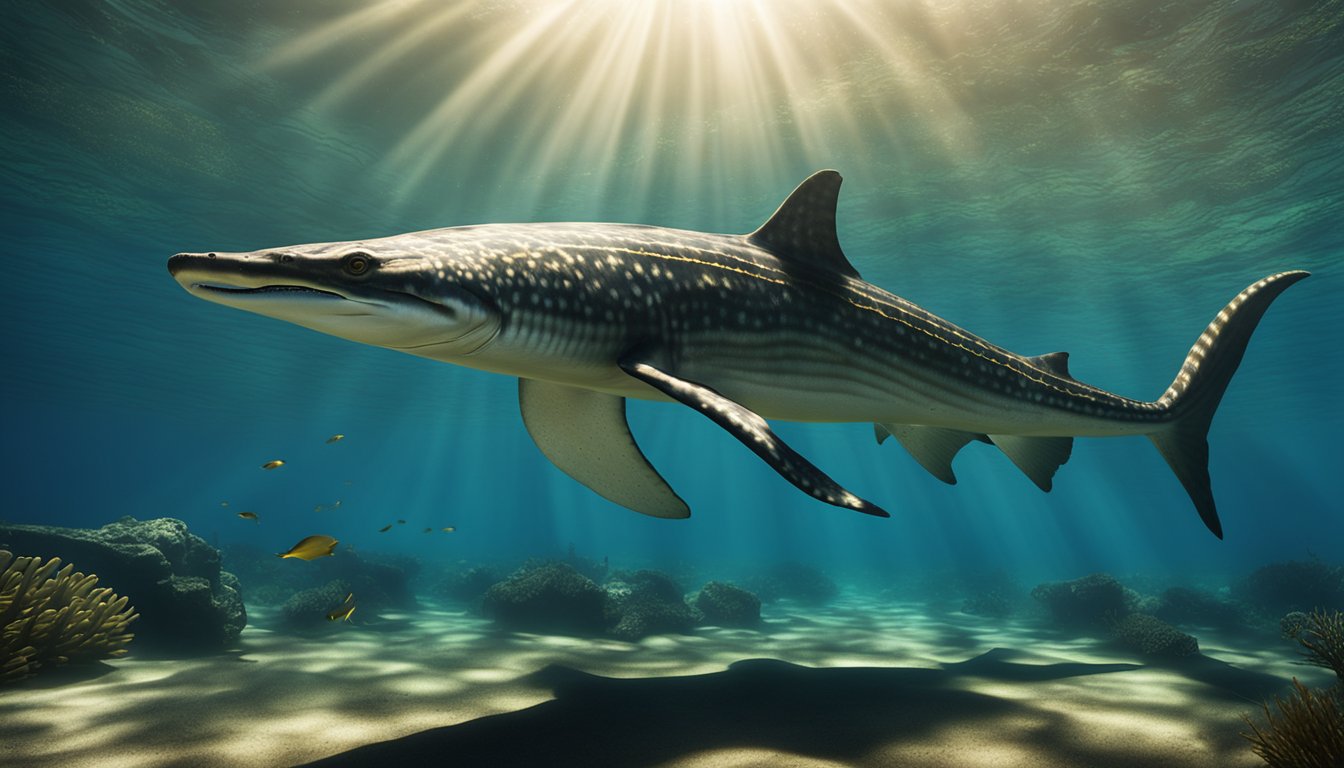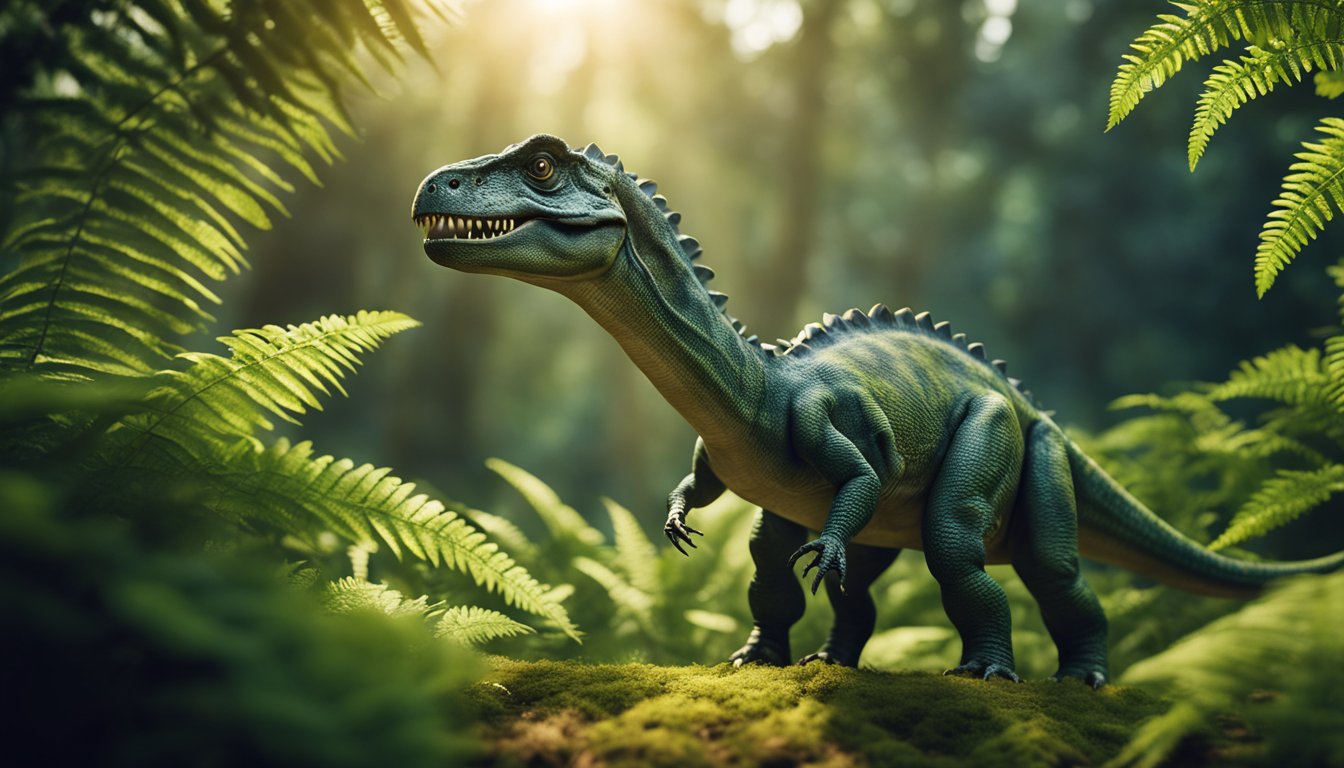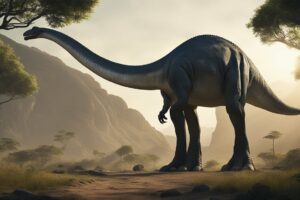Discover the Fascinating World of Ichthyosaurus and its Reign Over the Oceans of the Past
Ichthyosaurus, also known as the fish-lizard, was a fascinating marine reptile that ruled the Jurassic seas.
With its sleek body and long snout, the Ichthyosaurus was perfectly adapted to life in the water.
It was one of the most successful groups of reptiles to ever inhabit the oceans, and its fossils have been found all over the world.

Ichthyosaurs were not dinosaurs, but rather a separate group of reptiles that evolved to live in the water.
They first appeared about 250 million years ago, during the Triassic period, and went extinct about 90 million years ago, near the end of the Cretaceous period.
During their long reign, they evolved into a variety of shapes and sizes, from small, agile swimmers to massive, slow-moving giants.
The Ichthyosaurus was one of the smaller species, growing up to about 3 meters in length.
Despite its relatively small size, it was a formidable predator, with sharp teeth and powerful jaws that allowed it to catch and eat fish, squid, and other marine creatures.
The Jurassic seas were a time of great diversity and abundance, with a wide variety of marine life thriving in the warm, shallow waters.
The Ichthyosaurus was one of the most successful predators of this time, and its fossils have been found all over the world, from Europe to North America to Australia.
Today, scientists continue to study these fascinating creatures, using new technologies and techniques to unlock the secrets of their biology and evolution.
Unveiling the Ichthyosaurus
The Ichthyosaurus, also known as the “Fish-Lizard,” is a prehistoric marine reptile that lived during the Jurassic period, around 200 million years ago.
The name Ichthyosaurus means “fish lizard,” which is a fitting description of this incredible creature that ruled the Jurassic seas.
Defining Characteristics
The Ichthyosaurus had many defining characteristics that made it unique.
It had a streamlined body with a long, pointed snout and sharp teeth that helped it catch its prey.
Its body was covered in smooth skin, and it had a dorsal fin and two paddles that it used to swim through the water.
Size and Physical Features
The Ichthyosaurus came in many shapes and sizes, with some species measuring up to 23 meters in length.
Its most notable physical features were its large eyes, which were the size of basketballs, and its long, powerful tail that it used to propel itself through the water.
The tail was also used for steering and could move from side to side to help the Ichthyosaurus navigate through the water.
The Ichthyosaurus Family Tree
The Ichthyosaurus belongs to the family of marine reptiles known as Ichthyosauria, which translates to “fish lizards.” This family of reptiles was very successful and had many species, including the Stenopterygius, Temnodontosaurus, and Ophthalmosaurus.
The Ichthyosauria family is part of the larger group of reptiles known as Ichthyopterygia, which includes all marine reptiles that lived during the Mesozoic era.
The Ichthyosaurus is a fascinating creature that provides a glimpse into the prehistoric world.
Its fossils have been found all over the world, and scientists continue to study them to learn more about this incredible creature.
Did you know that some Ichthyosaurus species had up to 200 teeth in their jaws?
Imagine what it would be like to see one of these creatures swimming through the water!
Life in the Jurassic Oceans

During the Jurassic period, the oceans were teeming with life, and one of the most fascinating creatures that roamed the seas was the Ichthyosaurus, also known as the “fish-lizard.” These marine reptiles were the top predators of their time and ruled the oceans for millions of years.
Habitat and Distribution
Ichthyosaurs lived in oceans all around the world, from the Arctic to the tropics.
They preferred shallow waters near the coast, but they could also venture out into deeper waters.
Some species of Ichthyosaurs were even adapted to living in freshwater environments.
Diet and Predatory Behavior
Ichthyosaurs were fierce predators that fed on a variety of prey, including fish, squid, and other marine reptiles.
They had sharp teeth that were perfect for catching and holding onto their prey.
Some species of Ichthyosaurs had long, slender jaws that were ideal for catching fish, while others had shorter, more robust jaws that were better suited for eating squid and other soft-bodied prey.
Reproduction and Raising Young
Ichthyosaurs were viviparous, which means that they gave birth to live young.
Unlike most reptiles, which lay eggs, Ichthyosaurs carried their young inside their bodies until they were fully developed.
This allowed them to give birth to larger, more developed offspring that were better able to survive in the harsh ocean environment.
Overall, Ichthyosaurs were fascinating creatures that played an important role in the Jurassic oceans.
They were top predators that ruled the seas for millions of years, and their unique adaptations allowed them to thrive in a variety of environments.
The Evolutionary Journey

Ichthyosaurus, the mighty fish-lizard, was a highly successful marine reptile that ruled the seas during the Mesozoic Era.
The evolutionary journey of this fascinating creature is a story of adaptation and survival that spans millions of years.
From Land to Sea
Ichthyosaurs evolved from terrestrial reptiles that lived during the Triassic period, about 250 million years ago.
These early reptiles were probably similar to modern lizards and had four legs.
Over time, some of these reptiles began to venture into the water, developing adaptations that allowed them to swim more efficiently.
They gradually lost their legs and evolved into streamlined, fish-like creatures that were perfectly adapted to life in the water.
During the Jurassic period, Ichthyosaurs had evolved into a diverse group of marine reptiles that dominated the seas.
Some were small and agile, while others were massive and slow-moving.
They had elongated snouts with sharp teeth, which they used to catch fish and other prey.
Their bodies were streamlined and muscular, allowing them to swim at high speeds for extended periods.
Convergent Evolution with Modern Marine Animals
Ichthyosaurs were not the only marine creatures that evolved to resemble fish.
Modern dolphins and whales also have elongated snouts and streamlined bodies that are perfectly adapted to life in the water.
This is an example of convergent evolution, where unrelated species evolve similar traits due to similar environmental pressures.
Despite their success, Ichthyosaurs eventually went extinct during the Cretaceous period, about 90 million years ago.
The exact cause of their extinction is still unknown, but it is believed to be related to changes in the environment and competition from other marine reptiles.
In conclusion, the evolutionary journey of Ichthyosaurus is a fascinating story of adaptation and survival.
From their humble beginnings as terrestrial reptiles to their dominance of the Jurassic seas, these creatures evolved to become some of the most successful marine reptiles of all time.
Their story is a reminder of the incredible diversity of life on our planet and the power of evolution to shape it.
Discovering Ichthyosaurus Fossils

Fossil Sites Around the World
Ichthyosaurus fossils have been discovered in many parts of the world, including Germany, England, and Nevada.
The fossils are typically found in marine sediments, indicating that these creatures lived in the oceans.
The fossils are often well-preserved, with some even showing soft tissues such as skin and internal organs.
One of the most famous sites for Ichthyosaurus fossils is the Berlin-Ichthyosaur State Park in Nevada.
The park is home to a large collection of Ichthyosaurus fossils, including some of the largest specimens ever found.
Visitors to the park can see these fossils on display in the park’s museum.
Mary Anning and the Lyme Regis Discoveries
One of the most important figures in the history of Ichthyosaurus fossils is Mary Anning.
Anning was a fossil hunter who lived in Lyme Regis, England during the early 19th century.
She discovered several important Ichthyosaurus fossils in the cliffs around Lyme Regis, including the first complete Ichthyosaurus skeleton ever found.
Anning’s discoveries helped to shed light on the anatomy and behavior of these creatures.
Her work also helped to establish the science of paleontology as a legitimate field of study.
Today, visitors to Lyme Regis can visit the Mary Anning Museum to learn more about her life and work.
The museum also houses a collection of Ichthyosaurus fossils, including some of Anning’s original specimens.
Fun fact: Ichthyosaurus lived during the Triassic, Jurassic, and Cretaceous periods, which spanned a total of over 150 million years.
Frequently Asked Questions

What did Ichthyosaurs typically eat during their reign in the seas?
Ichthyosaurs were carnivorous predators that fed on a variety of marine creatures, including fish, squid, and other reptiles.
Some species of Ichthyosaurs had pointed teeth that were ideal for catching fast-moving prey, while others had flatter teeth that were better suited for crushing hard-shelled animals like clams and snails.
How big could an Ichthyosaur get, and how does that size compare to modern marine animals?
Ichthyosaurs ranged in size from just a few feet to over 50 feet long, with some of the largest species rivaling the size of modern-day blue whales.
Despite their massive size, Ichthyosaurs were agile swimmers that could reach impressive speeds in the water.
Can you find Ichthyosaur fossils today, and what do they tell us about these ancient creatures?
Yes, Ichthyosaur fossils have been found all over the world, from Europe to North America to Asia.
These fossils give us valuable insights into the anatomy, behavior, and evolution of these ancient creatures.
For example, scientists have used Ichthyosaur fossils to study the evolution of marine reptiles and to better understand the ecological dynamics of Jurassic-era oceans.
When did Ichthyosaurs go extinct, and what factors contributed to their disappearance?
Ichthyosaurs went extinct around 90 million years ago, during the Late Cretaceous period.
The exact cause of their extinction is still a subject of debate among scientists, but some theories include changes in ocean temperature and chemistry, competition from other marine predators, and the impact of a large asteroid or comet.
Why are Ichthyosaurs not considered dinosaurs, despite their prehistoric existence?
Although Ichthyosaurs lived during the same time period as dinosaurs, they are not considered dinosaurs themselves.
This is because they belong to a different group of reptiles called Ichthyopterygia.
While both dinosaurs and Ichthyosaurs were reptiles, they evolved along different branches of the evolutionary tree and had distinct anatomical features.
Where in the world’s oceans did Ichthyosaurs primarily live, and what was their habitat like?
Ichthyosaurs were primarily found in the shallow seas that covered much of the Earth during the Jurassic and Cretaceous periods.
They were particularly abundant in the warm, tropical waters that surrounded the supercontinent of Pangaea.
These seas were home to a diverse array of marine life, including other reptiles, fish, and invertebrates.






